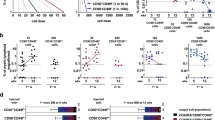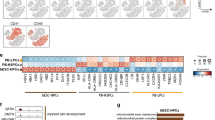Abstract
Recently, we purified from adult murine bone marrow (BM) a population of CXCR4+, Oct-4+ SSEA-1+, Sca-1+ lin− CD45− very small embryonic-like (VSEL) stem cells and hypothesized that similar cells could be also present in human cord blood (CB). Here, we report that by employing a novel two-step isolation procedure – removal of erythrocytes by hypotonic lysis combined with multiparameter sorting – we could isolate from CB a population of human cells that are similar to murine BM-derived VSELs, described previously by us. These CB-isolated VSELs (CB-VSEL) are very small (3–5 μm) and highly enriched in a population of CXCR4+AC133+CD34+lin− CD45− CB mononuclear cells, possess large nuclei containing unorganized euchromatin and express nuclear embryonic transcription factors Oct-4 and Nanog and surface embryonic antigen SSEA-4. Further studies are needed to see if human CB-isolated VSELs similar to their murine BM-derived counterparts are endowed with pluripotent stem cell properties.
This is a preview of subscription content, access via your institution
Access options
Subscribe to this journal
Receive 12 print issues and online access
$259.00 per year
only $21.58 per issue
Buy this article
- Purchase on Springer Link
- Instant access to full article PDF
Prices may be subject to local taxes which are calculated during checkout




Similar content being viewed by others
References
Shyu WC, Lin SZ, Yang HI, Tzeng YS, Pang CY, Yen PS et al. Functional recovery of stroke rats induced by granulocyte colony-stimulating factor-stimulated stem cells. Circulation 2004; 110: 1847–1854.
Buzanska L, Machaj EK, Zablocka B, Pojda Z, Domanska-Janik K . Human cord blood-derived cells attain neuronal and glial features in vitro. J Cell Sci 2002; 115: 2131–2138.
Pesce M, Orlandi A, Iachininoto MG, Straino S, Torella AR, Rizzuti V et al. Myoendothelial differentiation of human umbilical cord blood-derived stem cells in ischemic limb tissues. Circ Res 2003; 93: e51–e62.
Di Campli C, Piscaglia AC, Pierelli L, Rutella S, Bonanno G, Alison MR et al. A human umbilical cord stem cell rescue therapy in a murine model of toxic liver injury. Dig Liver Dis 2004; 36: 603–613.
Newsome PN, Johannessen I, Boyle S, Dalakas E, McAulay KA, Samuel K et al. Human cord blood-derived cells can differentiate into hepatocytes in the mouse liver with no evidence of cellular fusion. Gastroenterology 2003; 124: 1891–1900.
Wagers AJ, Weissman IL . Plasticity of adult stem cells. Cell 2004; 116: 639–648.
Mezey E, Chandross KJ, Harta G, Maki RA, McKercher SR . Turning blood into brain: cells bearing neuronal antigens generated in vivo from bone marrow. Science 2000; 290: 1779–1782.
Castro RF, Jackson KA, Goodell MA, Robertson CS, Liu H, Shine HD . Failure of bone marrow cells to transdifferentiate into neural cells in vivo. Science 2002; 297: 1299.
Nygren JM, Jovinge S, Breitbach M, Sawen P, Roll W, Hescheler J et al. Bone marrow-derived hematopoietic cells generate cardiomyocytes at a low frequency through cell fusion, but not transdifferentiation. Nat Med 2004; 10: 494–501.
Murry CE, Soonpaa MH, Reinecke H, Nakajima H, Nakajima HO, Rubart M et al. Haematopoietic stem cells do not transdifferentiate into cardiac myocytes in myocardial infarcts. Nature 2004; 428: 664–668.
Orkin SH, Zon LI . Hematopoiesis and stem cells: plasticity versus developmental heterogeneity. Nat Immunol 2002; 3: 323–328.
Ratajczak MZ, Kucia M, Reca R, Majka M, Janowska-Wieczorek A, Ratajczak J . Stem cell plasticity revisited: CXCR4-positive cells expressing mRNA for early muscle, liver and neural cells ‘hide out’ in the bone marrow. Leukemia 2004; 18: 29–40.
Kogler G, Sensken S, Airey JA, Trapp T, Muschen M, Feldhahn N et al. A new human somatic stem cell from placental cord blood with intrinsic pluripotent differentiation potential. J Exp Med 2004; 200: 123–135.
Jankowski K, Kucia M, Wysoczynski M, Reca R, Zhao D, Trzyna E et al. Both hepatocyte growth factor (HGF) and stromal-derived factor-1 regulate the metastatic behavior of human rhabdomyosarcoma cells, but only HGF enhances their resistance to radiochemotherapy. Cancer Res 2003; 63: 7926–7935.
Kucia M, Reca R, Campbell FR, Zuba-Surma E, Majka M, Ratajczak J et al. A population of very small embryonic-like (VSEL) CXCR4(+)SSEA-1(+)Oct-4+ stem cells identified in adult bone marrow. Leukemia 2006; 20: 857–869.
Yu H, Fang D, Kumar SM, Li L, Nguyen TK, Acs G et al. Isolation of a novel population of multipotent adult stem cells from human hair follicles. Am J Pathol 2006; 168: 1879–1888.
Ling TY, Kuo MD, Li CL, Yu AL, Huang YH, Wu TJ et al. Identification of pulmonary Oct-4+ stem/progenitor cells and demonstration of their susceptibility to SARS coronavirus (SARS-CoV) infection in vitro. Proc Natl Acad Sci USA 2006; 103: 9530–9535.
Johnson J, Bagley J, Skaznik-Wikiel M, Lee HJ, Adams GB, Niikura Y et al. Oocyte generation in adult mammalian ovaries by putative germ cells in bone marrow and peripheral blood. Cell 2005; 122: 303–315.
Guan K, Nayernia K, Maier LS, Wagner S, Dressel R, Lee JH et al. Pluripotency of spermatogonial stem cells from adult mouse testis. Nature 2006; 440: 1199–1203.
Orlic D, Kajstura J, Chimenti S, Jakoniuk I, Anderson SM, Li B et al. Bone marrow cells regenerate infarcted myocardium. Nature 2001; 410: 701–705.
Almeida-Porada G, Porada CD, Chamberlain J, Torabi A, Zanjani ED . Formation of human hepatocytes by human hematopoietic stem cells in sheep. Blood 2004; 104: 2582–2590.
Sanchez-Ramos JR . Neural cells derived from adult bone marrow and umbilical cord blood. J Neurosci Res 2002; 69: 880–893.
Schwartz RE, Reyes M, Koodie L, Jiang Y, Blackstad M, Lund T et al. Multipotent adult progenitor cells from bone marrow differentiate into functional hepatocyte-like cells. J Clin Invest 2002; 109: 1291–1302.
Terada N, Hamazaki T, Oka M, Hoki M, Mastalerz DM, Nakano Y et al. Bone marrow cells adopt the phenotype of other cells by spontaneous cell fusion. Nature 2002; 416: 542–545.
Terashima T, Kojima H, Fujimiya M, Matsumura K, Oi J, Hara M et al. The fusion of bone-marrow-derived proinsulin-expressing cells with nerve cells underlies diabetic neuropathy. Proc Natl Acad Sci USA 2005; 102: 12525–12530.
Alvarez-Dolado M, Pardal R, Garcia-Verdugo JM, Fike JR, Lee HO, Pfeffer K et al. Fusion of bone-marrow-derived cells with Purkinje neurons, cardiomyocytes and hepatocytes. Nature 2003; 425: 968–973.
Ishikawa F, Shimazu H, Shultz LD, Fukata M, Nakamura R, Lyons B et al. Purified human hematopoietic stem cells contribute to the generation of cardiomyocytes through cell fusion. FASEB J 2006; 20: 950–952.
Kucia M, Reca R, Jala VR, Dawn B, Ratajczak J, Ratajczak MZ . Bone marrow as a home of heterogenous populations of nonhematopoietic stem cells. Leukemia 2005; 19: 1118–1127.
Kucia M, Zhang YP, Reca R, Wysoczynski M, Machalinski B, Majka M et al. Cells enriched in markers of neural tissue-committed stem cells reside in the bone marrow and are mobilized into the peripheral blood following stroke. Leukemia 2006; 20: 18–28.
Kucia M, Dawn B, Hunt G, Guo Y, Wysoczynski M, Majka M et al. Cells expressing early cardiac markers reside in the bone marrow and are mobilized into the peripheral blood after myocardial infarction. Circ Res 2004; 95: 1191–1199.
Virchow R . Editorial Archive fuer pathologische. Anat Physiol Klin Med 1855; 8: 23–54.
Jordan HE . The History of the Primordial Germ Cells in the Loggerhead Turtle Embryo. Proc Natl Acad Sci USA 1917; 3: 271–275.
Kucia M, Ratajczak J, Ratajczak MZ . Bone marrow as a source of circulating CXCR4+ tissue-committed stem cells. Biol Cell 2005; 97: 133–146.
Dyce PW, Wen L, Li J . In vitro germline potential of stem cells derived from fetal porcine skin. Nat Cell Biol 2006; 8: 384–390.
Nayernia K, Lee JH, Drusenheimer N, Nolte J, Wulf G, Dressel R et al. Derivation of male germ cells from bone marrow stem cells. Lab Invest 2006; 86: 654–663.
Jiang Y, Jahagirdar BN, Reinhardt RL, Schwartz RE, Keene CD, Ortiz-Gonzalez XR et al. Pluripotency of mesenchymal stem cells derived from adult marrow. Nature 2002; 418: 41–49.
D'Ippolito G, Diabira S, Howard GA, Menei P, Roos BA, Schiller PC . Marrow-isolated adult multilineage inducible (MIAMI) cells, a unique population of postnatal young and old human cells with extensive expansion and differentiation potential. J Cell Sci 2004; 117: 2971–2981.
Jiang Y, Vaessen B, Lenvik T, Blackstad M, Reyes M, Verfaillie CM . Multipotent progenitor cells can be isolated from postnatal murine bone marrow, muscle, and brain. Exp Hematol 2002; 30: 896–904.
Acknowledgements
This work was supported by an NIH Grants R01 CA106281-01 and R01 DK074720 to MZR. The technical help of Kathy Caple from the University of Louisville for preparing TEM analysis is also appreciated. We thank Dr R Czajka from the Pomeranian Medical University in Szczecin, Poland and Dr J Sotomayor from the Foundation ‘Babies for Life’ from Atlanta, Georgia for supporting us with fresh human CB samples.
Author information
Authors and Affiliations
Corresponding author
Rights and permissions
About this article
Cite this article
Kucia, M., Halasa, M., Wysoczynski, M. et al. Morphological and molecular characterization of novel population of CXCR4+ SSEA-4+ Oct-4+ very small embryonic-like cells purified from human cord blood – preliminary report. Leukemia 21, 297–303 (2007). https://doi.org/10.1038/sj.leu.2404470
Received:
Accepted:
Published:
Issue Date:
DOI: https://doi.org/10.1038/sj.leu.2404470
Keywords
This article is cited by
-
Isolation of Swine Bone Marrow Lin-/CD45-/CD133 + Cells and Cardio-protective Effects of its Exosomes
Stem Cell Reviews and Reports (2023)
-
Histone demethylase KDM5B catalyzed H3K4me3 demethylation to promote differentiation of bone marrow mesenchymal stem cells into cardiomyocytes
Molecular Biology Reports (2022)
-
Hypes and Hopes of Stem Cell Therapies in Dentistry: a Review
Stem Cell Reviews and Reports (2022)
-
Industrialized GMP Production of CD34+ Cells (ProtheraCytes®) at Clinical Scale for Treatment of Ischemic Cardiac Diseases Is Feasible and Safe
Stem Cell Reviews and Reports (2022)
-
Expression of SSEA-4 and Oct-4 from somatic cells in primary mouse gastric cell culture induced by brief strong acid
Molecular and Cellular Biochemistry (2021)



